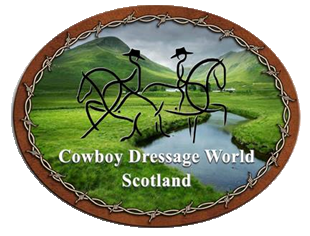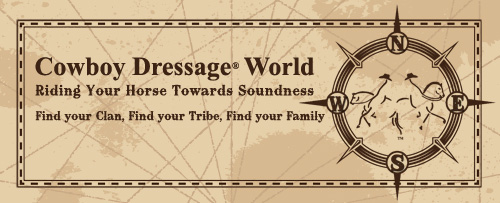
This beautiful letter was posted on Cowboy Dressage® World of Scotland Facebook Page. It was so “right on” we wanted to share it with all of you.
Thank you Brandon McAuslan for your heartfelt words……
Cowboy Dressage® World of Scotland
I recently had the privilege of taking part in the first official Cowboy Dressage clinic held in Scotland, and I thought it would be worthwhile putting across some of my thoughts about this new equestrian sport.
If you don’t already know me, I generally consider myself to be a dressage rider in a western saddle/attire. I have a very strong interest in classical horsemanship – and therefore attempt to combine classical training philosophies with a modern scientific understanding of horses. If I am reading a book about horsemanship it’s equally likely to be the writings of Nuno Oliviera or François Baucher as Bill Dorrance or Ray hunt.
In general I would say I admire two equestrian sports/pursuits above all others. Classical dressage and reined cow horse. Most modern horse sports I feel have suffered the same malady that affects all human competitive pursuits. In time the expectations of movement, refinement and power have become further and further exaggerated. The horse’s movements are becoming less and less natural in the pursuit of a more extravagant, bombastic and extreme display of athleticism. Like all facets of sporting life our propensity over time is to look for and expect things to become bigger, faster, harder and stronger. Unfortunately the brunt of this responsibility to perform falls upon our horses. How much more extreme and dangerous will the obstacles on cross country courses be in 10 years? How much longer faster and harder will the reining horse be expected to slide in 10 years? How much more extreme, confined and unnatural will the gaits of the modern dressage horse become in 10 years? And how much more uncomfortable looking and slow will the various gaits of the western pleasure horse become?
The beauty of the classical method is that it is much more a tradition and art than it is a competitive pursuit. The expectations placed on the horse have remained the same for hundreds (arguably thousands) of years. The purpose of classical horsemanship is to physically develop the horse with thought, compassion and patience, in a consistent manner, with longevity in mind.
The competitive pursuit of reined cow horse has a unique advantage over other equestrian pursuits in that there is one individual at every event responsible for maintaining the quality of natural movement for the horses involved – as well as the focus and direction of the sport. I am of course referring to the ordinary cow (or cows) at the center of this sport. The fact that a cow is used in the competition keeps the training and use of the horse both natural and practical. There is little desire to alter the self-carriage or breed the conformation of the horse into an exaggerated appearance as this will affect the horse’s ability to work a cow (and therefore defeating the purpose of the sport).
I’ve observed the evolution of Cowboy dressage over the last few years and kept an interested eye on the sport. To me it combines my love of classical horsemanship with the romantic, honest, and practical roots of the cowboy.
I have also observed the emergence of Western dressage. My honest opinion of that sport is that it is so close to conventional modern dressage that I don’t see the purpose in having both. Cowboy dressage is different.
Rather than simply sticking a western appearance on top of modern dressage, cowboy dressage offers to place the humanity, history and culture of western horsemanship within the context of a classical system of riding. Cowboy dressage is different from any other form of dressage in that a primary focus is at all times the welfare and comfort of the horse – which is a special and unique nucleus for a horse riding sport.
It is permitted to use vocal cues during a test. It is permitted to pet your horse during a test. It is permitted to have other horses in the arena (but outside the court) to help calm young or troubled horses prone to stress during a test. It is permitted to have a caller at every level of competition. Many will argue that this demeans the nature and gravity of dressage, but I would suggest that this in fact brings the entirety of focus onto the most important fact – how the rider and the horse complete their test in harmony with each other – everything else is considered peripheral, (but in a positive and decent way), any support or practical assistance that can be landed to horse and rider is not only permitted, it is encouraged.
Competitions are referred to as gatherings (in the spirit of the western ranches where gatherings for branding etc. are also often a celebratory get together). Any conventional bit or item of tack is permitted on a horse of any age – the focus is on the rider’s use of equipment rather than the equipment itself. Horses are expected to show natural carriage and way of going, with understandable and practical exceptions made for individual breeds and gaited horses.
The greatest aspect of this new equestrian sport for me is the fact that the term “soft feel” is of the highest judging criteria.
Last weekend my partner took her mare to our regular dressage facility for a day out (and to practice a couple of prelim tests). In the warm up arena I witnessed every other horse with its mouth strapped shut not only with a tight nose band – but an overly tight flash as well. One poor horse was being ridden aggressively whilst wearing a very severe tie down. No one in the warm up arena seemed interested in any transitions. I did not witness one half halt. What I saw was a group of poor horses audibly struggling to breath, worked hard whilst strapped down looking at the arena floor – either by gimmick equipment or the riders own unyielding hands. Every horse was relentlessly being forced forward, forward, forward. This was all normal and acceptable… My partner though was reprimanded for having a chin strap/snaffle hobble on her eggbut snaffle. This is why the world needs cowboy dressage.
I’ll admit the title is an unfortunate one as the “cowboy” connotation will be an obstacle to overcome western movie preconceptions outside of the United States. The ethos, focus and soul of the organization though is something that all disciplines of horse riding could learn from.
I stand alone as an oddity in the horse industry of Scotland. I’m a man invested in a form of horsemanship thousands of miles removed from his own home and own heritage. Even within the western community I am often viewed with scorn or derision because I admire and teach a form of classical horsemanship that is different from the common western pleasure, trail and showing centric techniques. So I have a personal and vested interest in hoping cowboy dressage grows roots here. More so than this, but for the benefit of all I hope cowboy dressage can flourish at home and abroad. Many people would benefit enormously from learning about “soft feel”. For the many people who love their horses, love to learn, or love dressage – yet feel intimidated or burned out from an often stern or unkind competition scene – cowboy dressage can offer you a welcoming supportive new form of competition.
BMc Horsemanship +44 7872 579734 Email brandonmcauslan@googlemail.com
For more information visit www.cowboydressage.com
